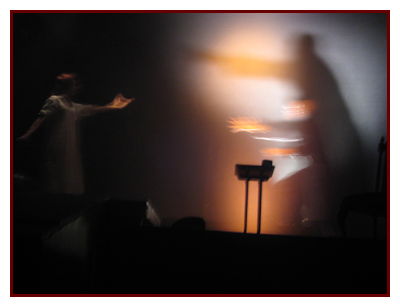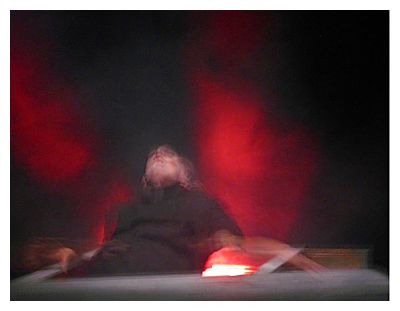Review: Nosferatu by Weird City Theatre
by Michael Meigs
If you're looking for dark and spooky, then Weird City Theatre Company has got dark and spooky for you, down at the Dougherty Arts Center for the Thursday to Sunday Halloween weekend.
These connoisseurs of the unnerving have blended Bram Stoker's Dracula and F.W. Murnau's unauthorized German expressionist film knock-off of the novel for a short, satisfying evening of the eerie.
You could view the 84-minute video of Murnau's 1922 silent film as preserved by the Cinemathèque française with an orchestral soundtrack either at Google video or at YouTube, but it may well be more fun to see Weird City reincarnate both the characters and the ghosts of those actors now long dead and gone.
Stoker's epistolary novel Dracula of 1897 is also available, through Project Gutenberg. It's quite a read and the story is far more extensive than Murnau's film. As a young teenager I had a lively red-haired friend who was entranced by the novel. All I knew of it were glimpses of clunky movies seen on television.
Scanning the downloaded text all these years later I begin to understand why a relatively innocent early adolescent would go for that mannered adventure story written by an Irish contemporary of Mary Shelley and Henry Irving. For example, after arriving at Count Dracula's castle in the Carpathians to close the sale of a mansion in his home town, one evening young solicitor Jonathan Harker disregards the Count's advice and drowses off in the library. He vaguely senses the presence of three women in the darkness, one of whom approaches him. He feigns sleep.
"I was afraid to raise my eyelids, but looked out and saw perfectly under the lashes. The girl went on her knees, and bent over me, simply gloating. There was a deliberate voluptuousness which was both thrilling and repulsive, and as she arched her neck she actually licked her lips like an animal, till I could see in the moonlight the moisture shining on the scarlet lips and on the red tongue as it lapped the white sharp teeth. Lower and lower went her head as the lips went below the range of my mouth and chin and seemed to fasten on my throat. Then she paused, and I could hear the churning sound of her tongue as it licked her teeth and lips, and I could feel the hot breath on my neck. Then the skin of my throat began to tingle as one's flesh does when the hand that is to tickle it approaches nearer, nearer. I could feel the soft, shivering touch of the lips on the super sensitive skin of my throat, and the hard dents of two sharp teeth, just touching and pausing there. I closed my eyes in languorous ecstasy and waited, waited with beating heart."
 The Weird City script put together by Carroll and John W. Smith doesn't attempt such flights of soft porn. In fact, not until very late in the piece is there any female vampire at all. The basic structure is that of Murnau's film, but they do borrow good dramatic bits from the novel. For example, on the first morning in the castle, Harker starts to shave. The Count seizes Harker's hand mirror and breaks it -- and then, of their own Weird invention, they have the Count pick up that straight razor, flourish it and with a caressing touch give the surprised Harker his shave.
The Weird City script put together by Carroll and John W. Smith doesn't attempt such flights of soft porn. In fact, not until very late in the piece is there any female vampire at all. The basic structure is that of Murnau's film, but they do borrow good dramatic bits from the novel. For example, on the first morning in the castle, Harker starts to shave. The Count seizes Harker's hand mirror and breaks it -- and then, of their own Weird invention, they have the Count pick up that straight razor, flourish it and with a caressing touch give the surprised Harker his shave.
As in the film, Harker is detained for a month at the Count's castle, reads a book about local superstitions and realizes belatedly that those earth-filled boxes destined for the new property are really bad juju. He escapes and heads for home. Separately, the sailing ship transporting the cargo of the damned arrives in harbor with crew disappeared and the captain dead, tied to the wheel. A mysterious plague then afflicts the town (folks are found dead in the morning, with gashes in their necks).
Mina's friend Lucy falls victim and comes back undead. Our hero Jonathan makes it to town and seeks to raise the alarm. Mina has learned that the vampire will die only if satiated by innocent blood voluntarily given and then surprised by the cock's crow at dawn. The intrepid Dr. Van Helsing is treating the sick and begins to perceive the problem.
The Weird City surprise ending is neither the film's whimpering finale nor the involved, ultimately happily-ever-after resolution of the novel. Theirs is a quick ghoulish twist very much in keeping with the cheerfully macabre humor of this bunch. Lighting design by Philip B. Richard as run by Stephen Reynolds puts the action in reduced light most of the time, and actors are often half-shadows standing out against blackness. The visuals are in some ways similar to an old black-and-white film, except without Murnau's creepy closeups and haunting visions of washed-out landscapes. The concept worked, but I would have preferred those dimmer switches to have been set a couple of notches higher.
Lighting design by Philip B. Richard as run by Stephen Reynolds puts the action in reduced light most of the time, and actors are often half-shadows standing out against blackness. The visuals are in some ways similar to an old black-and-white film, except without Murnau's creepy closeups and haunting visions of washed-out landscapes. The concept worked, but I would have preferred those dimmer switches to have been set a couple of notches higher.

The silhouetted figure of the lurking Count Orlach and shadow projections were highly effective, and the creepiest moment of all was his red-tinged emergence from that boxy coffin dominating center stage.
This play has lots of dreams and visions. It's a son et lumièremorality play of sorts, accompanied by Robert Berry's score and Marty Lester's sound design.
There's not a lot of room for character development with these events. John Carroll as Harker is a doughty chap and looks pretty good in 19th century traveling gear. Co-adapter John W. Smith drools, quivers and excesses appropriately as the gradually maddening Renfield, expatriate servant to the Count. Nicholas Kier has a striking presence as Count Orlach, thanks in part to that remarkable make-up designed by Amelia Turner. He controls the necessarily extravagant personality of the vampire, making him a creepily believable menace. The ladies are 19th century demure until they get the chance to be otherwise.
Yes, we love to be scared, and the enthusiastic Saturday night crowd embraced it all. You, too, can spend some time with the undead this coming weekend at the Dougherty Arts Center.
You'll be keeping Austin a Weird City Theatre venue.
Review by Elizabeth Cobbe in the Austin Chronicle, October 29
Review by Ryan E. Johnson at examiner.com, October 30
Review by Rob Faubion at AustinOnStage, November 1
EXTRA
Click to view program for Nosferatu by Weird City Theatre Company
Hits as of 2015 03 01: 1880
Nosferatu
by adapted by John Carroll from F.W. Murnau's film
Weird City Theatre
